Leadership and Motivation in Sustainability Report
VerifiedAdded on 2023/01/18
|7
|1458
|23
Report
AI Summary
This report explores the intersection of sustainability and employee motivation, focusing on Herzberg's two-factor theory. It examines how companies like AGL Energy and Commonwealth Bank of Australia apply this theory to motivate executive-level employees through financial and non-financial incentives, including the triple bottom line framework. The report highlights how aligning business practices with economic, social, and environmental considerations strengthens employee motivation by addressing both hygiene and motivator factors. It emphasizes the importance of leadership in fostering a sustainable work environment that enhances employee engagement and performance, ultimately leading to organizational success and stakeholder support. The report provides a comprehensive analysis of how sustainable practices and effective leadership contribute to a motivated workforce, supported by academic references and real-world examples.
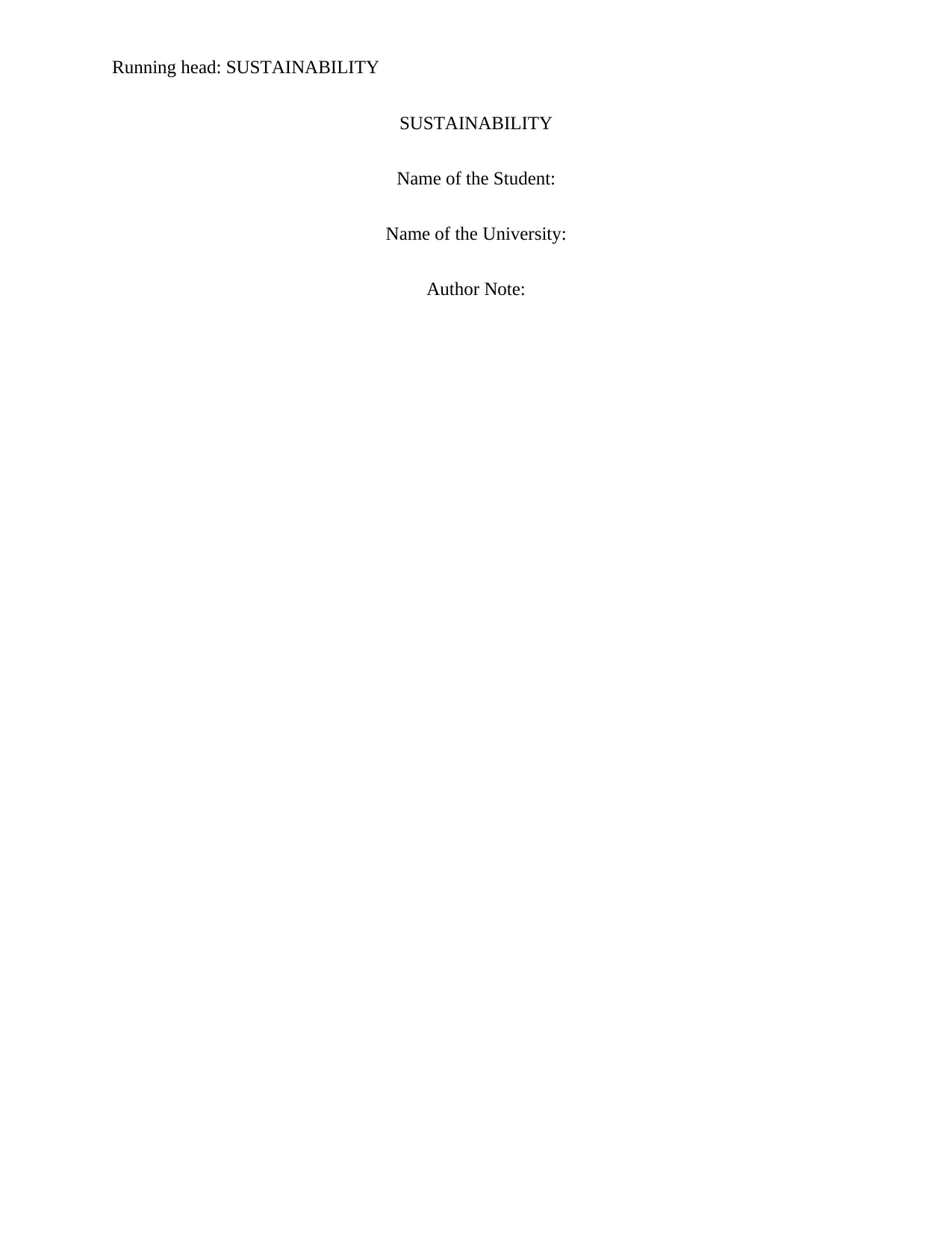
Running head: SUSTAINABILITY
SUSTAINABILITY
Name of the Student:
Name of the University:
Author Note:
SUSTAINABILITY
Name of the Student:
Name of the University:
Author Note:
Paraphrase This Document
Need a fresh take? Get an instant paraphrase of this document with our AI Paraphraser
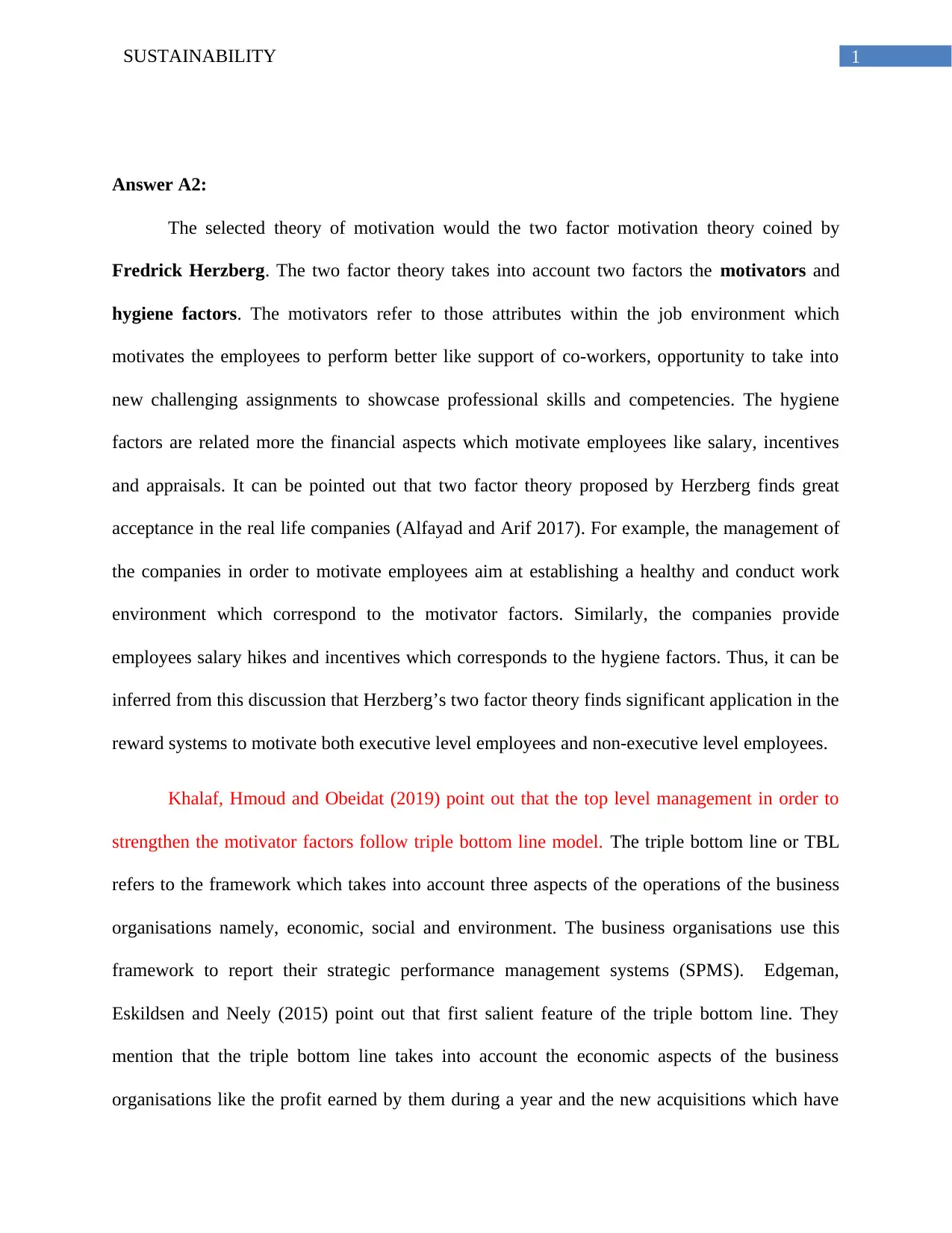
1SUSTAINABILITY
Answer A2:
The selected theory of motivation would the two factor motivation theory coined by
Fredrick Herzberg. The two factor theory takes into account two factors the motivators and
hygiene factors. The motivators refer to those attributes within the job environment which
motivates the employees to perform better like support of co-workers, opportunity to take into
new challenging assignments to showcase professional skills and competencies. The hygiene
factors are related more the financial aspects which motivate employees like salary, incentives
and appraisals. It can be pointed out that two factor theory proposed by Herzberg finds great
acceptance in the real life companies (Alfayad and Arif 2017). For example, the management of
the companies in order to motivate employees aim at establishing a healthy and conduct work
environment which correspond to the motivator factors. Similarly, the companies provide
employees salary hikes and incentives which corresponds to the hygiene factors. Thus, it can be
inferred from this discussion that Herzberg’s two factor theory finds significant application in the
reward systems to motivate both executive level employees and non-executive level employees.
Khalaf, Hmoud and Obeidat (2019) point out that the top level management in order to
strengthen the motivator factors follow triple bottom line model. The triple bottom line or TBL
refers to the framework which takes into account three aspects of the operations of the business
organisations namely, economic, social and environment. The business organisations use this
framework to report their strategic performance management systems (SPMS). Edgeman,
Eskildsen and Neely (2015) point out that first salient feature of the triple bottom line. They
mention that the triple bottom line takes into account the economic aspects of the business
organisations like the profit earned by them during a year and the new acquisitions which have
Answer A2:
The selected theory of motivation would the two factor motivation theory coined by
Fredrick Herzberg. The two factor theory takes into account two factors the motivators and
hygiene factors. The motivators refer to those attributes within the job environment which
motivates the employees to perform better like support of co-workers, opportunity to take into
new challenging assignments to showcase professional skills and competencies. The hygiene
factors are related more the financial aspects which motivate employees like salary, incentives
and appraisals. It can be pointed out that two factor theory proposed by Herzberg finds great
acceptance in the real life companies (Alfayad and Arif 2017). For example, the management of
the companies in order to motivate employees aim at establishing a healthy and conduct work
environment which correspond to the motivator factors. Similarly, the companies provide
employees salary hikes and incentives which corresponds to the hygiene factors. Thus, it can be
inferred from this discussion that Herzberg’s two factor theory finds significant application in the
reward systems to motivate both executive level employees and non-executive level employees.
Khalaf, Hmoud and Obeidat (2019) point out that the top level management in order to
strengthen the motivator factors follow triple bottom line model. The triple bottom line or TBL
refers to the framework which takes into account three aspects of the operations of the business
organisations namely, economic, social and environment. The business organisations use this
framework to report their strategic performance management systems (SPMS). Edgeman,
Eskildsen and Neely (2015) point out that first salient feature of the triple bottom line. They
mention that the triple bottom line takes into account the economic aspects of the business
organisations like the profit earned by them during a year and the new acquisitions which have
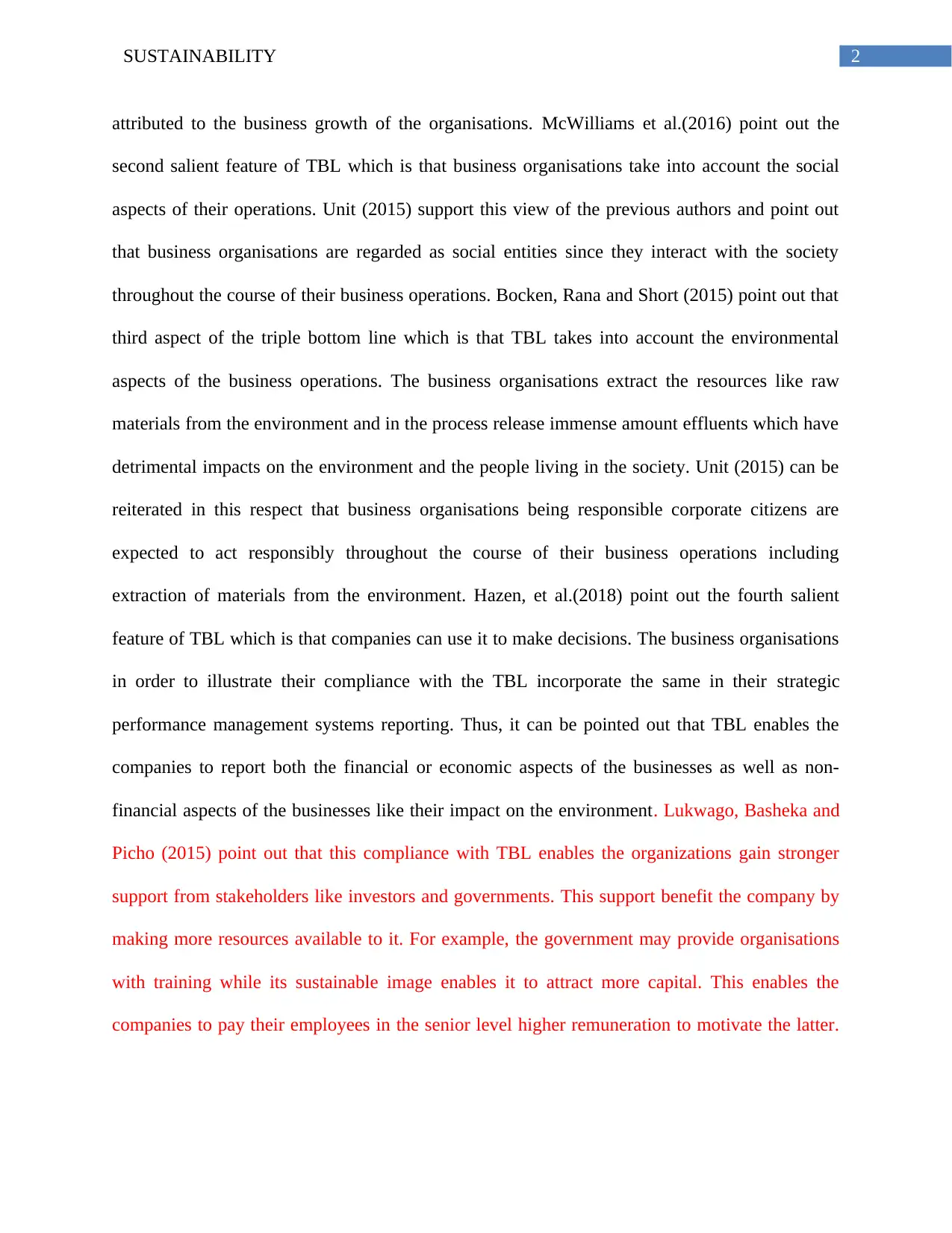
2SUSTAINABILITY
attributed to the business growth of the organisations. McWilliams et al.(2016) point out the
second salient feature of TBL which is that business organisations take into account the social
aspects of their operations. Unit (2015) support this view of the previous authors and point out
that business organisations are regarded as social entities since they interact with the society
throughout the course of their business operations. Bocken, Rana and Short (2015) point out that
third aspect of the triple bottom line which is that TBL takes into account the environmental
aspects of the business operations. The business organisations extract the resources like raw
materials from the environment and in the process release immense amount effluents which have
detrimental impacts on the environment and the people living in the society. Unit (2015) can be
reiterated in this respect that business organisations being responsible corporate citizens are
expected to act responsibly throughout the course of their business operations including
extraction of materials from the environment. Hazen, et al.(2018) point out the fourth salient
feature of TBL which is that companies can use it to make decisions. The business organisations
in order to illustrate their compliance with the TBL incorporate the same in their strategic
performance management systems reporting. Thus, it can be pointed out that TBL enables the
companies to report both the financial or economic aspects of the businesses as well as non-
financial aspects of the businesses like their impact on the environment. Lukwago, Basheka and
Picho (2015) point out that this compliance with TBL enables the organizations gain stronger
support from stakeholders like investors and governments. This support benefit the company by
making more resources available to it. For example, the government may provide organisations
with training while its sustainable image enables it to attract more capital. This enables the
companies to pay their employees in the senior level higher remuneration to motivate the latter.
attributed to the business growth of the organisations. McWilliams et al.(2016) point out the
second salient feature of TBL which is that business organisations take into account the social
aspects of their operations. Unit (2015) support this view of the previous authors and point out
that business organisations are regarded as social entities since they interact with the society
throughout the course of their business operations. Bocken, Rana and Short (2015) point out that
third aspect of the triple bottom line which is that TBL takes into account the environmental
aspects of the business operations. The business organisations extract the resources like raw
materials from the environment and in the process release immense amount effluents which have
detrimental impacts on the environment and the people living in the society. Unit (2015) can be
reiterated in this respect that business organisations being responsible corporate citizens are
expected to act responsibly throughout the course of their business operations including
extraction of materials from the environment. Hazen, et al.(2018) point out the fourth salient
feature of TBL which is that companies can use it to make decisions. The business organisations
in order to illustrate their compliance with the TBL incorporate the same in their strategic
performance management systems reporting. Thus, it can be pointed out that TBL enables the
companies to report both the financial or economic aspects of the businesses as well as non-
financial aspects of the businesses like their impact on the environment. Lukwago, Basheka and
Picho (2015) point out that this compliance with TBL enables the organizations gain stronger
support from stakeholders like investors and governments. This support benefit the company by
making more resources available to it. For example, the government may provide organisations
with training while its sustainable image enables it to attract more capital. This enables the
companies to pay their employees in the senior level higher remuneration to motivate the latter.
⊘ This is a preview!⊘
Do you want full access?
Subscribe today to unlock all pages.

Trusted by 1+ million students worldwide
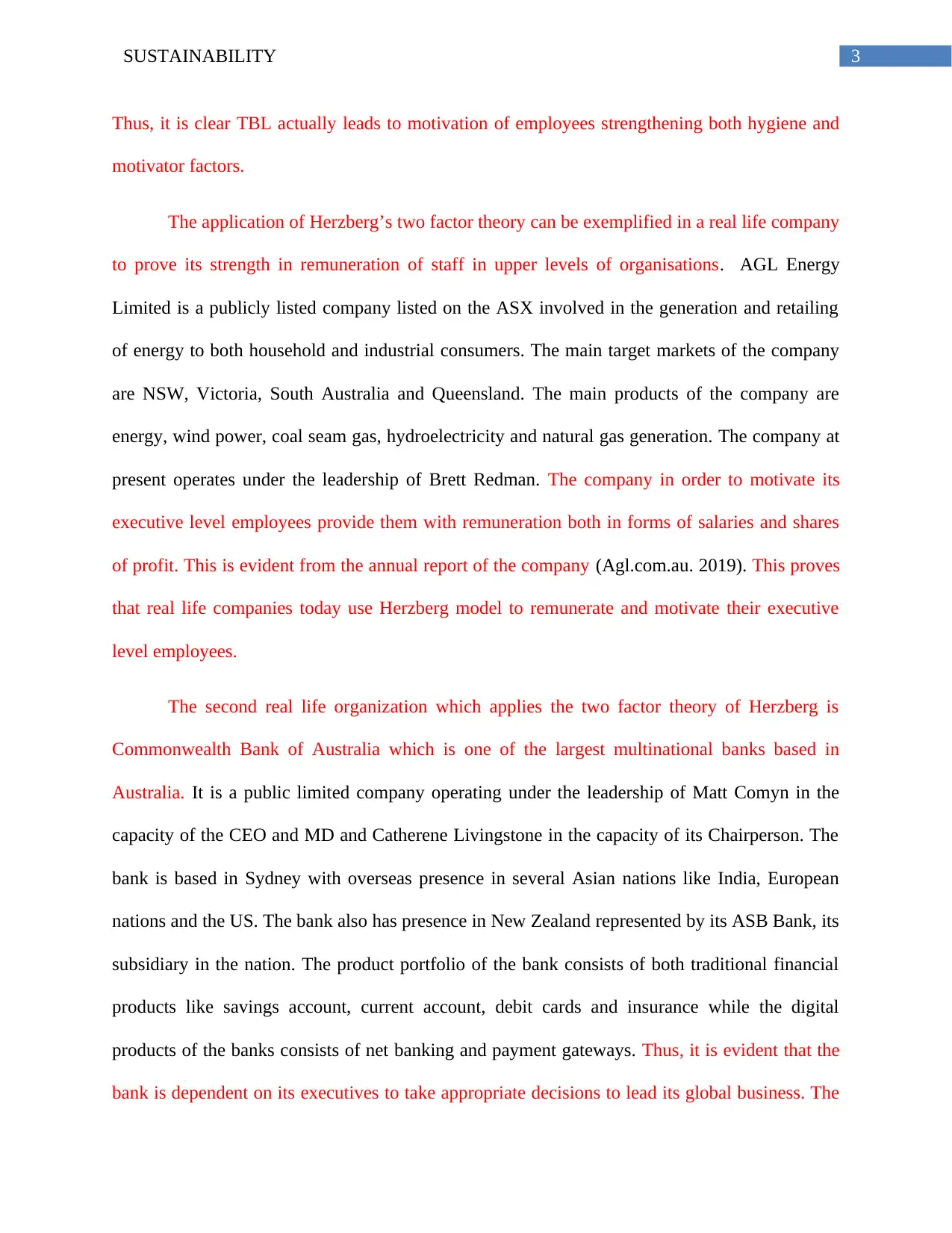
3SUSTAINABILITY
Thus, it is clear TBL actually leads to motivation of employees strengthening both hygiene and
motivator factors.
The application of Herzberg’s two factor theory can be exemplified in a real life company
to prove its strength in remuneration of staff in upper levels of organisations. AGL Energy
Limited is a publicly listed company listed on the ASX involved in the generation and retailing
of energy to both household and industrial consumers. The main target markets of the company
are NSW, Victoria, South Australia and Queensland. The main products of the company are
energy, wind power, coal seam gas, hydroelectricity and natural gas generation. The company at
present operates under the leadership of Brett Redman. The company in order to motivate its
executive level employees provide them with remuneration both in forms of salaries and shares
of profit. This is evident from the annual report of the company (Agl.com.au. 2019). This proves
that real life companies today use Herzberg model to remunerate and motivate their executive
level employees.
The second real life organization which applies the two factor theory of Herzberg is
Commonwealth Bank of Australia which is one of the largest multinational banks based in
Australia. It is a public limited company operating under the leadership of Matt Comyn in the
capacity of the CEO and MD and Catherene Livingstone in the capacity of its Chairperson. The
bank is based in Sydney with overseas presence in several Asian nations like India, European
nations and the US. The bank also has presence in New Zealand represented by its ASB Bank, its
subsidiary in the nation. The product portfolio of the bank consists of both traditional financial
products like savings account, current account, debit cards and insurance while the digital
products of the banks consists of net banking and payment gateways. Thus, it is evident that the
bank is dependent on its executives to take appropriate decisions to lead its global business. The
Thus, it is clear TBL actually leads to motivation of employees strengthening both hygiene and
motivator factors.
The application of Herzberg’s two factor theory can be exemplified in a real life company
to prove its strength in remuneration of staff in upper levels of organisations. AGL Energy
Limited is a publicly listed company listed on the ASX involved in the generation and retailing
of energy to both household and industrial consumers. The main target markets of the company
are NSW, Victoria, South Australia and Queensland. The main products of the company are
energy, wind power, coal seam gas, hydroelectricity and natural gas generation. The company at
present operates under the leadership of Brett Redman. The company in order to motivate its
executive level employees provide them with remuneration both in forms of salaries and shares
of profit. This is evident from the annual report of the company (Agl.com.au. 2019). This proves
that real life companies today use Herzberg model to remunerate and motivate their executive
level employees.
The second real life organization which applies the two factor theory of Herzberg is
Commonwealth Bank of Australia which is one of the largest multinational banks based in
Australia. It is a public limited company operating under the leadership of Matt Comyn in the
capacity of the CEO and MD and Catherene Livingstone in the capacity of its Chairperson. The
bank is based in Sydney with overseas presence in several Asian nations like India, European
nations and the US. The bank also has presence in New Zealand represented by its ASB Bank, its
subsidiary in the nation. The product portfolio of the bank consists of both traditional financial
products like savings account, current account, debit cards and insurance while the digital
products of the banks consists of net banking and payment gateways. Thus, it is evident that the
bank is dependent on its executives to take appropriate decisions to lead its global business. The
Paraphrase This Document
Need a fresh take? Get an instant paraphrase of this document with our AI Paraphraser

4SUSTAINABILITY
bank is required to motivate its employees. The bank in order to motivate the executive level
employees pay them high salaries. Thus, it can again be proved that CBA uses Herzberg’s theory
to motivate its upper level employees.
bank is required to motivate its employees. The bank in order to motivate the executive level
employees pay them high salaries. Thus, it can again be proved that CBA uses Herzberg’s theory
to motivate its upper level employees.

5SUSTAINABILITY
References:
Agl.com.au. 2019. Agl.com.au. [online] Available at:
https://www.agl.com.au/about-agl/sustainability [Accessed 12 Apr. 2019].
Alfayad, Z. & Arif, L.S.M., 2017. Employee voice and job satisfaction: An application of
Herzberg two-factor theory. International Review of Management and Marketing, 7(1), pp.150-
156.
Bocken, N.M.P., Rana, P. & Short, S.W., 2015. Value mapping for sustainable business
thinking. Journal of Industrial and Production Engineering, 32(1), pp.67-81.
Commbank.com.au. 2019. Commbank.com.au. [online] Available at:
https://www.commbank.com.au/content/dam/commbank/about-us/shareholders/pdfs/results/
fy18/cba-annual-report-2018.pdf [Accessed 12 Apr. 2019].
Edgeman, R., Eskildsen, J. & Neely, A., 2015. Translating triple top line strategy into triple
bottom line performance. Measuring Business Excellence, 19(1).
Hazen, B.T., Skipper, J.B., Boone, C.A. & Hill, R.R., 2018. Back in business: Operations
research in support of big data analytics for operations and supply chain management. Annals of
Operations Research, 270(1-2), pp.201-211.
Khalaf, R.K.A., Hmoud, H.Y. & Obeidat, B., 2019. Reviewing the Mediating Role of Job
Satisfaction on the Effect of Employee Engagement on Organizational Performance. Journal of
Social Sciences (COES&RJ-JSS), 8, pp.7-23.
Lukwago, G., Basheka, B. & Picho, E.O., 2015. Developing a construct validity under
Herzberg’s theory for motivation of employees in the National Agricultural Research
References:
Agl.com.au. 2019. Agl.com.au. [online] Available at:
https://www.agl.com.au/about-agl/sustainability [Accessed 12 Apr. 2019].
Alfayad, Z. & Arif, L.S.M., 2017. Employee voice and job satisfaction: An application of
Herzberg two-factor theory. International Review of Management and Marketing, 7(1), pp.150-
156.
Bocken, N.M.P., Rana, P. & Short, S.W., 2015. Value mapping for sustainable business
thinking. Journal of Industrial and Production Engineering, 32(1), pp.67-81.
Commbank.com.au. 2019. Commbank.com.au. [online] Available at:
https://www.commbank.com.au/content/dam/commbank/about-us/shareholders/pdfs/results/
fy18/cba-annual-report-2018.pdf [Accessed 12 Apr. 2019].
Edgeman, R., Eskildsen, J. & Neely, A., 2015. Translating triple top line strategy into triple
bottom line performance. Measuring Business Excellence, 19(1).
Hazen, B.T., Skipper, J.B., Boone, C.A. & Hill, R.R., 2018. Back in business: Operations
research in support of big data analytics for operations and supply chain management. Annals of
Operations Research, 270(1-2), pp.201-211.
Khalaf, R.K.A., Hmoud, H.Y. & Obeidat, B., 2019. Reviewing the Mediating Role of Job
Satisfaction on the Effect of Employee Engagement on Organizational Performance. Journal of
Social Sciences (COES&RJ-JSS), 8, pp.7-23.
Lukwago, G., Basheka, B. & Picho, E.O., 2015. Developing a construct validity under
Herzberg’s theory for motivation of employees in the National Agricultural Research
⊘ This is a preview!⊘
Do you want full access?
Subscribe today to unlock all pages.

Trusted by 1+ million students worldwide
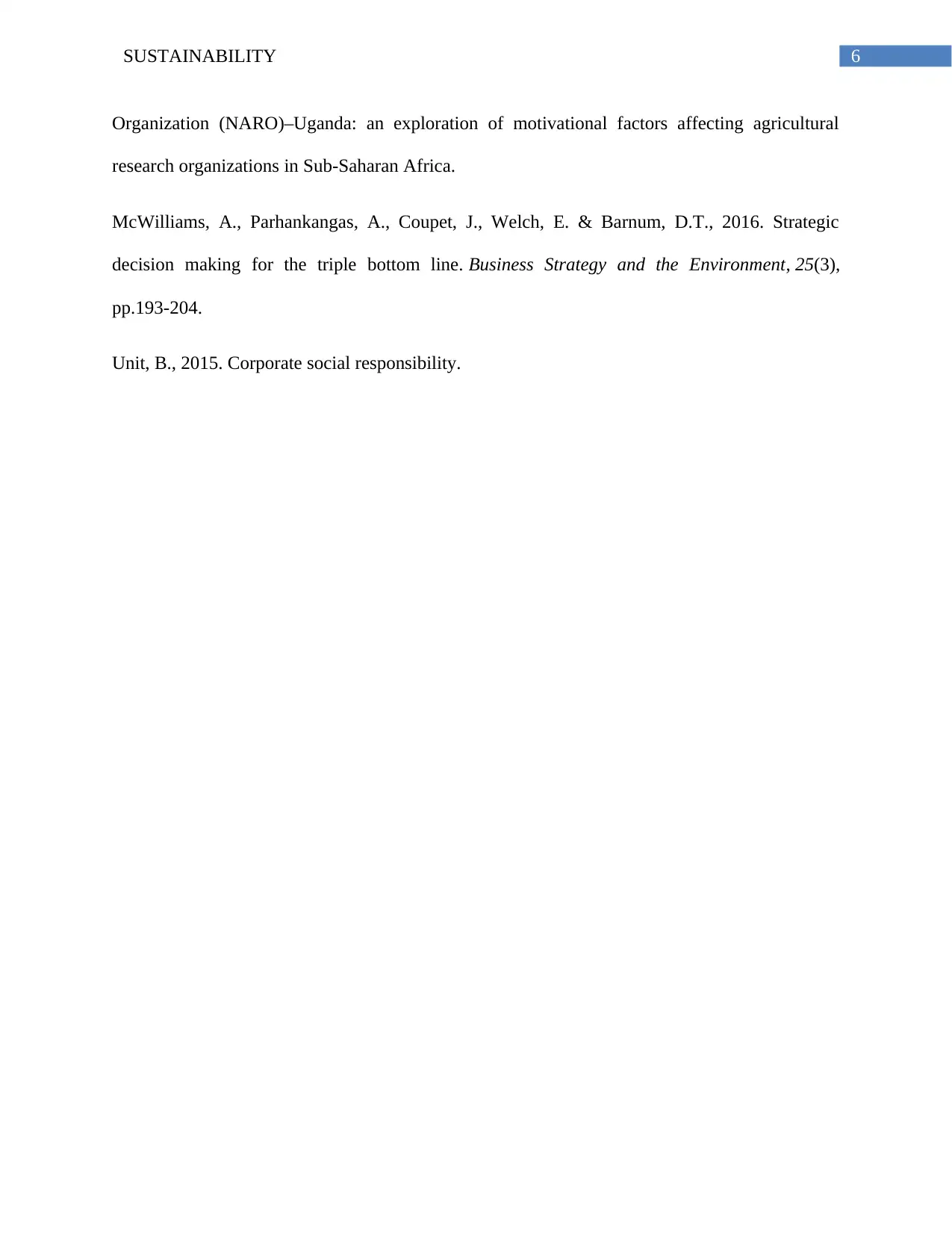
6SUSTAINABILITY
Organization (NARO)–Uganda: an exploration of motivational factors affecting agricultural
research organizations in Sub-Saharan Africa.
McWilliams, A., Parhankangas, A., Coupet, J., Welch, E. & Barnum, D.T., 2016. Strategic
decision making for the triple bottom line. Business Strategy and the Environment, 25(3),
pp.193-204.
Unit, B., 2015. Corporate social responsibility.
Organization (NARO)–Uganda: an exploration of motivational factors affecting agricultural
research organizations in Sub-Saharan Africa.
McWilliams, A., Parhankangas, A., Coupet, J., Welch, E. & Barnum, D.T., 2016. Strategic
decision making for the triple bottom line. Business Strategy and the Environment, 25(3),
pp.193-204.
Unit, B., 2015. Corporate social responsibility.
1 out of 7
Related Documents
Your All-in-One AI-Powered Toolkit for Academic Success.
+13062052269
info@desklib.com
Available 24*7 on WhatsApp / Email
![[object Object]](/_next/static/media/star-bottom.7253800d.svg)
Unlock your academic potential
Copyright © 2020–2025 A2Z Services. All Rights Reserved. Developed and managed by ZUCOL.





